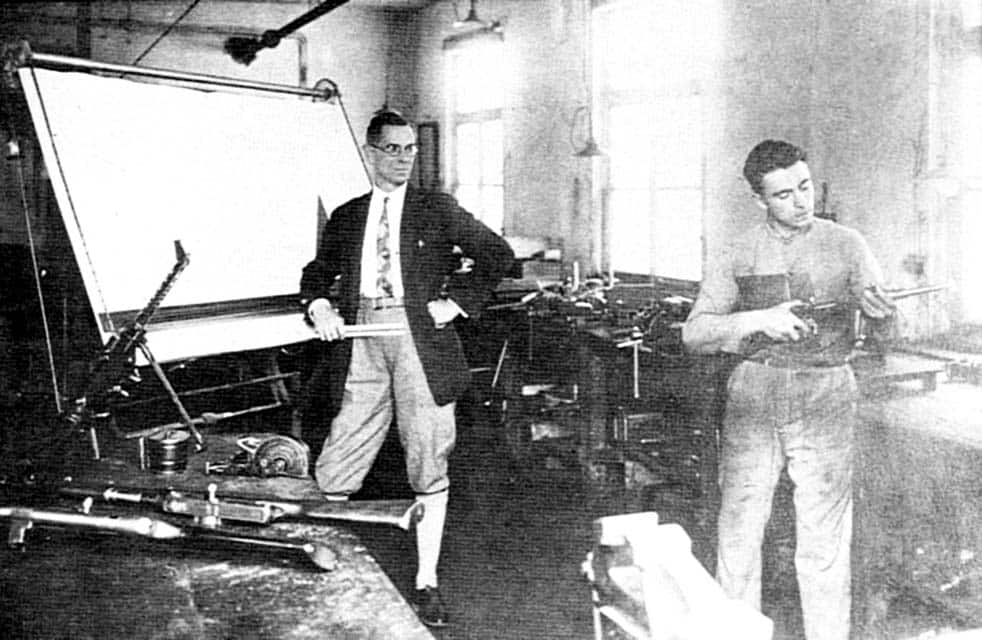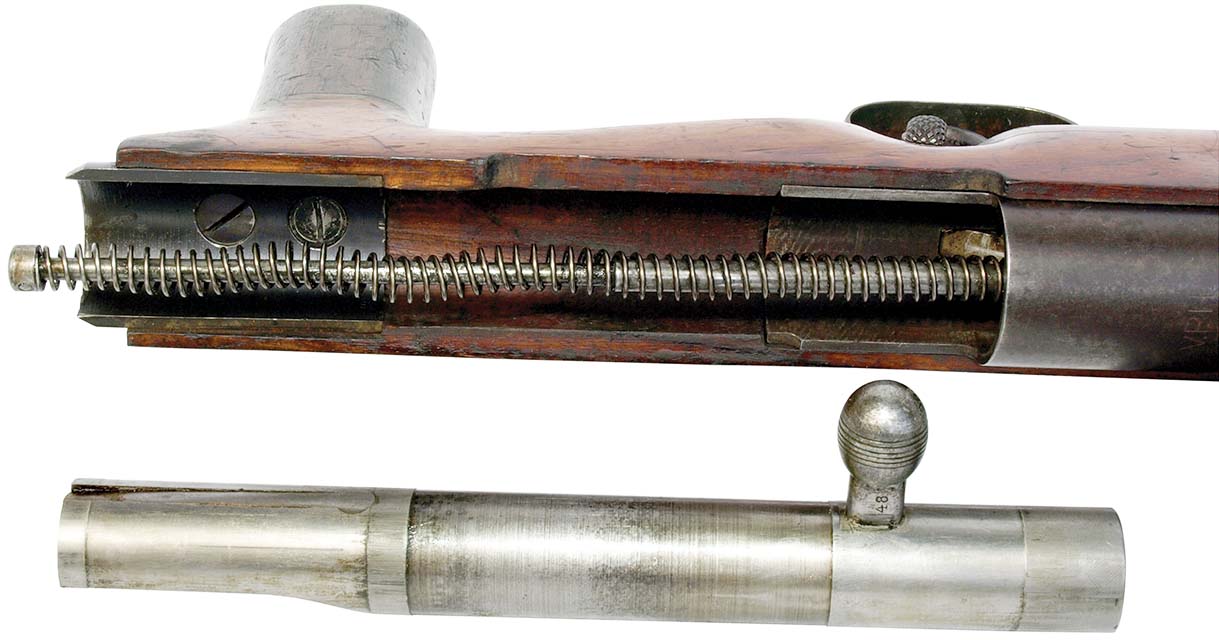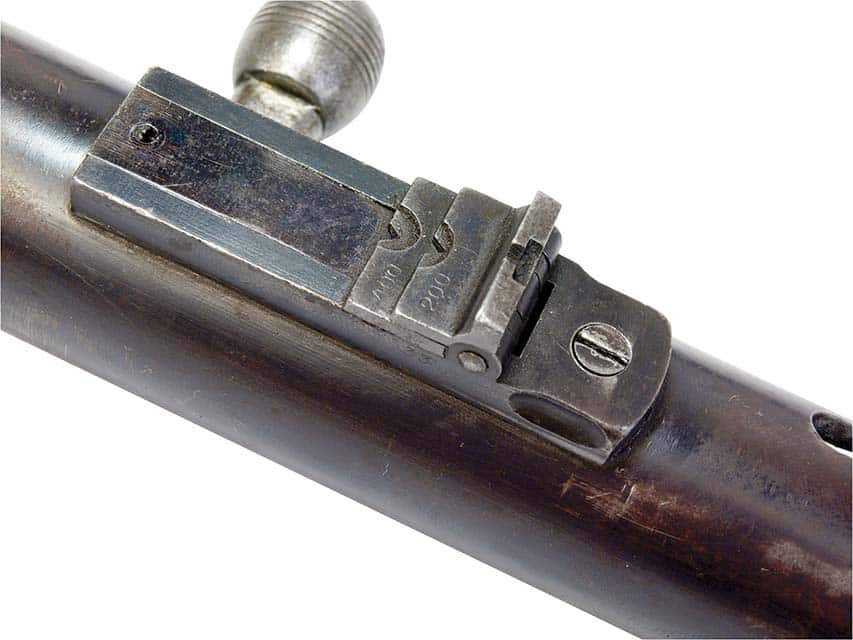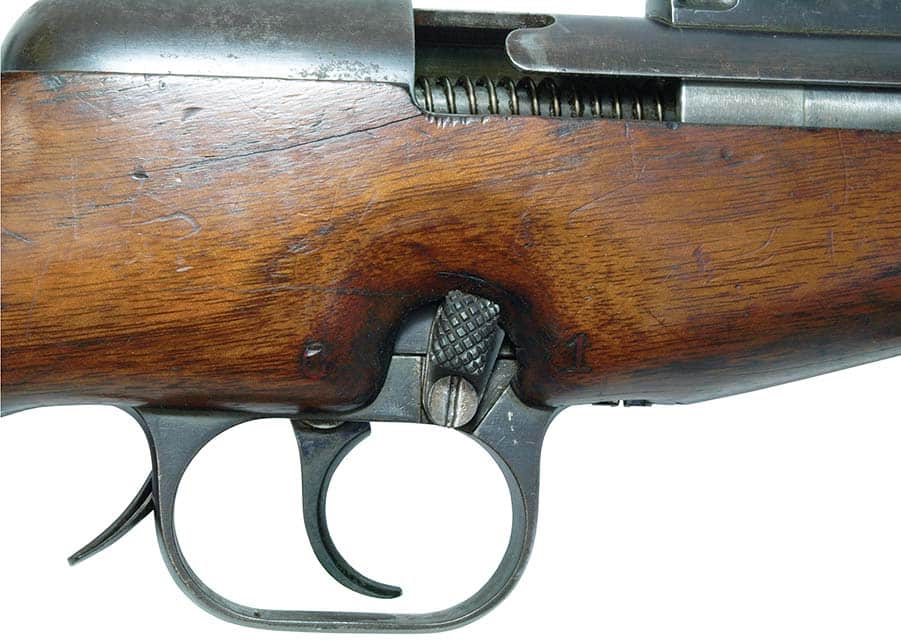By Michael Heidler

The history of the German submachine guns is closely connected with the engineer Heinrich Vollmer. His forward-looking ideas and his Swabian diligence brought him no great commercial success, but they formed the basis for the later famous weapons of the Erfurter Maschinenfabrik (ERMA).
Heinrich Vollmer, born on January 6, 1885, in a town near Stuttgart in southern Germany, founded his own machine tool factory in Biberach an der Riss in 1909 when he was 24 years old. At an early age, he was also interested in weapons technology and devoted himself to the development of body armor and similar equipment for the infantry—but without much success. His demonstration model failed in a test by the Prussian War Ministry in November 1912.
The Beltless Cartridge
Vollmer’s next idea was a beltless cartridge feeding device for heavy machine guns, which he worked on until the break out of World War I interrupted his work. He stopped his project and volunteered to serve the Fatherland, but he was not accepted because of his impaired eyesight. Instead, he got a contract from the royal rifle factories in Gdansk and Amberg for manufacturing muzzle protectors for the service rifle Gewehr 98. Both factories were at that time fully exploited. In addition, Vollmer’s company also manufactured various parts for the machine guns 08 and 08/ 15. For a long time, the production ran in several scattered workshops in Biberach, before Vollmer was able to move into a newly built factory complex in the same location in 1917. Towards the end of the War nearly 800 workers were employed in his company.

Vollmer again worked on his beltless cartridge feeding device for machine guns and also developed complete machine guns. Although they were noticed by the IWG (Inspection of Weapons and Equipment), none were adopted. Due to the scarcity of woven fabric and various difficulties with the cartridge belts in use, his cartridge feeding device was of great interest to the Spandau Rifle Examination Commission. Vollmer was commissioned to adapt his device to the MGs08 and 08/ 15. Everything went well, and the feeding device worked satisfactorily, but then in 1918 the War was over. The work in Vollmer’s factory had to be stopped.
The following years under the Versailles Treaty were not easy, especially not for a weapons designer like Heinrich Vollmer. Thus, his company completely transitioned to civilian products and again produced machine tools like before the War. Secretly, however, he continued to devote himself to the improvement of his beltless cartridge feeding device since the Reichswehr continued to express its interest. In the end it never came to an adoption because the new generation of machine guns no longer required such a device.

Inspiration
Impressed by the performance of the MP 18 SMG, Vollmer quickly realized the potential of this new type of weapon. And that’s how the idea of creating his own submachine gun matured. Vollmer had already dealt intensively with the ammunition feeding for automatic weapons, so he first tried to increase the ammunition supply of the MP 18,I. Like a flexible shaft, Heinrich Vollmer created a detachable magazine in which a coil spring was rotably mounted. Each coil of the spring carried one cartridge, which was then pushed forward by the rotation of the spring. To generate the required preload, the mechanism was driven by a wind-up clock spring, which was covered by a housing. This housing could hang around the soldier’s neck. The magazine had a capacity of 60 rounds, which were fed very reliably during trials.
In 1922 Vollmer secretly began with attempts to develop a complete submachine gun. And after tireless work, he finished his first own submachine gun which he designated the “VMP 25” (Vollmer Maschinenpistole 1925). It was a blowback-operated, selective-fire weapon which fired from the open bolt. The standard safety consisted of a hook-shaped notch in the receiver. It was used to engage and lock the bolt in the cocked position. A disassembly catch was located at the rear of the trigger guard. The VMP’s special characteristic was a vertical foregrip. In the course of time, this grip advanced to a trademark of all Vollmer submachine guns. The grip allowed a better hold of the weapon when firing bursts and also prevented the hand from touching the hot barrel. A small, drum-type magazine was attached below the receiver from the right and held 25 rounds of 9x19mm pistol ammunition.

VMP 26
After the IWG expressed interest in the VMP 25 and had granted financial support, Vollmer presented a further improved, mass-cooled model without barrel jacket (VMP 26) in October 1926. Competitors were such well-known names as Rheinmetall and Bergmann. Although the tests were satisfactory, the weapon was rejected. The recoil spring was too long, the capacity of the drum magazine with only 25 rounds was too low, and the loading procedure of the same was too complicated. One year later, Vollmer presented his revised model, the VMP 28, with a 30-round stick magazine inserted from the left. But outdated perceptions remain a long time: the Inspection of Weapons and Equipment criticized the missing barrel jacket.

Export to Other Countries
With his successor model VMP 30, Vollmer still had no luck. This time the high firing rate of 700 rounds per minute was criticized, and the weapon was rejected again. It was then 1930, and shortly afterwards, the Reichswehr withdrew from all these developments. Since the police were not interested in the weapon, Germany was no longer considered a business market. With the permission of the IWG, foreign states were contacted as potential customers. Vollmer offered his weapons in a variety of calibers, including 7.65×22 Luger, 7.63×25 Mauser and 9×25 Mauser Export. Various countries, especially Bulgaria, purchased weapons from Vollmer. In November 1927, even the Bulgarian Consul General stayed at the factory for the acceptance of a series of submachine guns. The weapons were shipped through Antwerp under the strictest secrecy.

Model Confusion
The designation of each model is extremely confusing. In most cases Vollmer marked the receivers only with a letter abbreviation, without additional model number, caliber or year. In particular, low double-digit serial numbers often led to incorrect model designations in the relevant literature, if these were considered to be abbreviated years. What hides behind the letter abbreviations is still largely unclear. In the series V.P.F., V.P.G. and V.P.H., the letter “V” will surely stand for “Vollmer” and the “P” for “pistol.” The third letter may then be in alphabetical order for the model.

The V.P.H. has a redesigned magazine well for inserting double-row, dual-feed stick magazines from the left. The use of drum magazines is no longer possible. This model corresponds to the weapon described in Vollmer’s documents as the “Modell 1928” (VMP 28). The recoil spring was still firmly fixed to the rear end of the lower receiver and was not yet covered by a protective telescope tube. Vollmer’s ingenious idea of the telescoping recoil spring assembly, which made the gun more reliable and easier to assemble and disassemble in the field, was for the first time used with the VMP 30. This same concept can later be found on the MP 38 and MP 40.


Hard Times
From 1930, no more government subsidies flowed to the medium-sized company. Financially stricken by the high development costs and few revenues, on October 21, 1931, Heinrich Vollmer signed a license agreement with the Erfurter Maschinenfabrik (ERMA) for the production of his VMP 30. Their boss Berthold Geipel believed in the future of the submachine gun and had the weapon revised: it now received a barrel coat again. The wooden stock with its characteristic foregrip and the telescopic recoil spring remained. Additionally, on some EMP weapons, a manual safety was installed on the left side of receiver, behind the magazine well. Exports went to South America, Bulgaria and Yugoslavia. In Spain, the weapon was manufactured under license in 9mm Largo. But despite all efforts, the EMP models soon no longer corresponded to the Zeitgeist. In Germany, the EMP was only acquired by the SS and the police. The army demanded a more modern submachine gun, lighter and more compact, and above all one suitable for firing from armored vehicles.
• • •
Thanks to Udo Vollmer and Bas Martens for their support.
| This article first appeared in Small Arms Review V23N9 (Nov 2019) |












